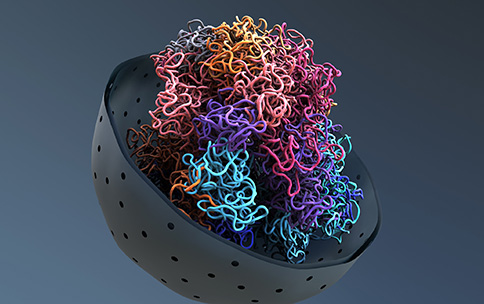
Inside the nucleus of every cell in the human body, over six feet of DNA – the genome – folds together into a dynamic structure called chromatin that packs into a space thirty times smaller than a grain of salt. Understanding how chromatin organization is controlled and how it affects gene activity is critical to understanding healthy cell function and may reveal new ways to treat disease. The Common Fund’s 4D Nucleome (4DN) program was launched in 2015 to investigate how chromatin organization occurs in different types of cells, how it changes over time, and how it relates to health and disease.
In the first phase of the 4DN program, researchers successfully developed many new technologies and refined existing approaches to measure and model nuclear chromatin organization.[1] The field of genomic research is being propelled forward by tools such as cleavage under targets and tagmentation (CUT&Tag), a method to measure how and where proteins bind to DNA.[2] CUT&Tag is faster, cheaper, and higher resolution than existing methods, and has been cited in over 400 studies. 4DN also created the 4DN Data Portal as a resource to make data on nuclear chromatin organization available to the entire research community, which hosts data from over 4,600 experiments generated by researchers from both inside and outside the 4DN consortium. These data are in high demand, with over 250 dataset downloads each month, and the 4DN Data Portal provides dozens of software packages and pipelines to expand the types of analyses possible with genomic data.
As 4DN research builds off the discoveries of Phase 1 and digs deeper into nuclear chromatin organization in mammalian tissues, 4DN researchers will continue to find new insights into the relationship between chromatin and human health. Studies using these tools are already demonstrating links between chromatin structures and disease, such as new findings from 4DN researchers on how mutated genes that can cause cancer are normally tucked away in the nucleus, making them inactive, but are exposed and activated by disruptions in chromatin structures in cancer cells.[3] Through its contributions to new technologies, data resources, and genomic studies, the 4DN program is leaving a lasting impact on the field of nuclear chromatin organization and will expand that impact in Phase 2.
References
- Elucidating the Structure and Function of the Nucleus - the NIH Common Fund 4D Nucleome Program. Roy AL, Conroy RS, Taylor VG, Mietz J, Fingerman IM, Pazin MJ, Smith P, Hutter CM, Singer DS, Wilder EL. Molecular Cell, 2023. doi: 10.1016/j.molcel.2022.12.025 Epub 2023 January 13.
Open Access Link (Active through March 4th, 2023) - CUT&Tag for Efficient Epigenomic Profiling of Small Samples and Single Cells. Kaya-Okur HS, Wu SJ, Codomo CA, Pledger ES, Bryson TD, Henikoff JG, Ahmad K, Henikoff S. Nat Commun, 2019 Apr 29;10(1):1930. doi: 10.1038/s41467-019-09982-5.
- Activation of Proto-Oncogenes by Disruption of Chromosome Neighborhoods. Hnisz D, Weintraub AS, Day DS, Valton AL, Bak RO, Li CH, Goldmann J, Lajoie BR, Fan ZP, Sigova AA, Reddy J, Borges-Rivera D, Lee TI, Jaenisch R, Porteus MH, Dekker J, Young RA. Science, 2016 Mar 25;351(6280):1454-1458. doi: 10.1126/science.aad9024. Epub 2016 Mar 3.


